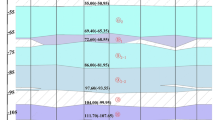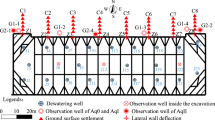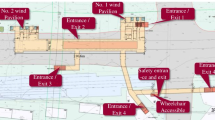Abstract
Water level is decreased during foundation pit excavation to avoid water inrush under confined water pressure. Cut-off wall is often used as waterproof curtain to partially cut off the dewatered aquifer. When a foundation pit is located in a built-up area and the underlying confined aquifer is not cut off, the drawdown must be minimized outside the pit to avoid land subsidence in buildings and pipelines. The coupling effect of the cut-off wall and pumping well is used to control the drawdown outside the foundation pit. However, the coupling mechanism is not intuitively well understood because of the limitations of existing experimental methods. In this study, transparent soil was introduced to model the coupling mechanism in the physical model test. High-purity fused silica and mixed paraffin oil were used as skeleton and fluid to simulate the confined aquifer and groundwater. Industrial solid dye and paraffin oil were used as tracers. A camera was used to collect flow information. Tests were performed for the combinations of cut-off wall and partially penetrating pumping wells. The insertion depth ratio of the cut-off wall most effectively influenced the drawdown. The layout of the pumping wells in horizontal direction influenced water level distribution and flow rate. The optimal depth of the pumping wells was 1–5 m above the bottom of the cut-off wall, and the optimal horizontal distance between the cut-off wall and the pumping wells was 25% of the pit width. Non-Darcy flow was observed within the range of 0–10 m around the bottom of the cut-off wall. These results were significant in understanding the cut-off wall and pumping well coupling effect on foundation pit dewatering.















Similar content being viewed by others
Abbreviations
- DDR:
-
Drawdown decreasing rate, it is equal to the water level difference of both sides of cut-off wall divided by the water level inside pit
- A :
-
Insertion depth that the cut-off wall penetrates into the confined aquifer
- B :
-
Horizontal distance between the pumping wells and the cut-off wall
- C :
-
Vertical distance from the bottom of the well screens to the bottom of the cut-off wall
- D :
-
Thickness of the confined aquifer
- a/D :
-
Insertion depth ratio of the cut-off wall
- L :
-
Well screen length
- N :
-
Pumping wells number
- \(\alpha_{l}\) :
-
Independent similarity ratio variables of geometry
- \(\alpha_{F}\) :
-
Independent similarity ratio variables of force
- \(\alpha_{t}\) :
-
Independent similarity ratio variables of time
- \(\alpha_{g}\) :
-
Independent similarity ratio variables of gravity
- \(\alpha_{P}\) :
-
Independent similarity ratio variables of pressure
- \(\alpha_{\Delta h}\) :
-
Independent similarity ratio variables of drawdown
- \(\alpha_{\rho }\) :
-
Independent similarity ratio variables of density
- \(\alpha_{v}\) :
-
Independent similarity ratio variables of flow velocity
- \(\alpha_{K}\) :
-
Independent similarity ratio variables of hydraulic conductivity
- \(\alpha_{\mu }\) :
-
Independent similarity ratio variables of viscosity
- \(\alpha_{Q}\) :
-
Independent similarity ratio variables of flow rate
- D :
-
Distance in Cartesian coordinate system (RGB color model)
- R u , G u , B u :
-
Identify point value of tracers in RGB color model
- R r , G r , B r :
-
Standard value of tracers in RGB color model
References
Bear J (1979) Hydraulics of groundwater. McGraw-Hill, New York
Behrooz-Koohenjani S, Samani N, Kompani-Zare M (2013) Steady flow to a partially penetrating blind-wall well in a confined aquifer. Hydrol Process 27(16):2271–2279. https://doi.org/10.1002/hyp.9353
Butler JJJ, Liu WZ (1991) Pumping tests in non-uniform aquifers—the linear strip case. J Hydrol 128(1–4):69–99. https://doi.org/10.1016/0022-1694(91)90132-2
Casagrande A (1937) Seepage through dams. J New England Water Works Assoc 51(2):131–172
Chen J, Wada N (1986) Visualization of immiscible displacement in a three-dimensional transparent porous medium. Exp Fluids 4(6):336–338. https://doi.org/10.1007/BF00266299
Cui ZD, Jia YJ, Yuan L (2016) Distribution law of soil deformation caused by decompression of confined water. Environ Earth Sci 75(18):1281. https://doi.org/10.1007/s12665-016-6075-6
Davis GM, Horswill P (2002) Groundwater control and stability in an excavation in magnesian limestone near Sunderland. Eng Geol 66(1):1–18. https://doi.org/10.1016/S0013-7952(01)00100-4
Debidin F, Lee CF (1980) Groundwater and drawdown in a large earth excavation. Can Geotech J 17(2):185–202. https://doi.org/10.1139/t80-022
Ding GP, Jiao JJ, Zhang DX (2008) Modelling study on the impact of deep building foundations on the groundwater system. Hydrol Proc 22(12):1857–1865. https://doi.org/10.1002/hyp.6768
Ezzein FM, Bathurst RJ (2011) A transparent sand for geotechnical laboratory modeling. Geotech Test J 34(6):1–12. https://doi.org/10.1520/GTJ103808
Farrell ER (1994) Analysis of groundwater flow through leaky marine retaining structures. Géotechnique 44(2):255–263. https://doi.org/10.1680/geot.1994.44.2.255
Fernandez SR, Iskander M, Tabe K (2011) 3D Contaminant flow imaging in transparent granular porous media. Geotech Lett 1(3):71–78. https://doi.org/10.1680/geolett.11.00027
Galloway DL, Jones DR, Ingebritsen SE (1999) Land subsidence in the United States, vol 1182. US Geological Survey Circular, Reston
Gao Y, Sui W, Liu J (2015) Visualization of chemical grout permeation in transparent soil. Geotech Test J 38(5):2477–2488. https://doi.org/10.1520/GTJ20140202
Gill D, Lehane B (2001) An optical technique for investigating soil displacement patterns. Geotech Test J 24(3):324–329. https://doi.org/10.1520/GTJ11351J
Griffith DV, Fenton GA (1993) Seepage beneath water retaining structures founded on spatially random soil. Géotechnique 43(4):577–587. https://doi.org/10.1680/geot.1993.43.4.577
Guzman IL, Iskander M, Suescun-Florez E, Omidvar M (2014) A transparent aqueous-saturated sand surrogate for use in physical modeling. Acta Geotech 9(2):187–206. https://doi.org/10.1007/s11440-013-0247-2
Harr ME (1962) Groundwater and seepage. McGraw-Hill, New York
Hird CC, Ni Q, Guymer I (2011) Physical modelling of deformations around piling augers in clay. Géotechnique 61(11):993–999. https://doi.org/10.1680/geot.9.T.028
Houben GJ (2015) Review: hydraulics of water wells—flow laws and influence of geometry. Hydrogeol J 23(8):1633–1657. https://doi.org/10.1007/s10040-015-1312-8
Houben GJ (2015) Review: hydraulics of water wells—head losses of individual components. Hydrogeol J 23(8):1659–1675. https://doi.org/10.1007/s10040-015-1313-7
Hsi J, Small J (1992) Ground settlements and drawdown of the water table around an excavation. Can Geotech J 29(5):740–756. https://doi.org/10.1139/t92-082
Iskander M (2010) Modelling with transparent soils: visualizing soil structure interaction and multi phase flow, non-intrusively. Springer, Berlin. https://doi.org/10.1007/978-3-642-02501-3
Iskander M, Lai J, Oswald C, Mannheimer R (1994) Development of a transparent material to model the geotechnical properties of soils. Geotech Test J 17(4):425–433. https://doi.org/10.1520/GTJ10303J
Iskander M, Liu J, Sadek S (2002) Transparent amorphous silica to model clay. J Geotech Geoenviron 128(3):262–273. https://doi.org/10.1061/(ASCE)1090-0241(2002)128:3(262)
Iskander M, Sadek S, Liu J (2002) Optical measurement of deformation using transparent silica gel to model sand. Int J Phys Model Geo 2(4):13–26. https://doi.org/10.1680/ijpmg.2002.020402
Iskander M, Bathurst RJ, Omidvar M (2015) Past, present, and future of transparent soils. Geotech Test J 38(5):393–401. https://doi.org/10.1520/gtj20150079
Kong GQ, Zhou LD, Wang TZ, Yang G, Li H (2016) Shear modulus and damping ratios of transparent soil manufactured by fused quartz. Mater Lett 182(1):257–259. https://doi.org/10.1016/j.matlet.2016.07.012
Lehane B, Gil D (2004) Displacement fields induced by penetrometer installation in an artificial soil. Int J Phys Model Geotech 4(1):25–36. https://doi.org/10.1680/ijpmg.2004.040103
Liu J (2003) Visualization of 3-d deformations using transparent ‘soil’ models. Ph.D. thesis, Polytechnic University of New York, Brooklyn, New York
Liu J, Iskander M, Sadek S (2003) Consolidation and permeability of transparent amorphous silica. Geotech Test J 26(4):390–401. https://doi.org/10.1520/GTJ11257J
Lo HC, Tabe K, Iskander M, Yoon SH (2010) A transparent water-based polymer for simulating multiphase flow. Geotech Test J 33(1):1–13. https://doi.org/10.1520/GTJ102375
Luo ZJ, Zhang YY, Wu YX (2008) Finite element numerical simulation of three-dimensional seepage control for deep foundation pit dewatering. J Hydrodyn 20(5):596–602. https://doi.org/10.1016/S1001-6058(08)60100-6
Ma Y, Kong XZ, Scheuermann A, Galindo-Torres SA, Bringemeier D, Li L (2015) Microbubble transport in water-saturated porous media. Water Resour Res 51(6):4359–4373. https://doi.org/10.1002/2014WR016019
Mannheimer R (1990) Slurries you can see through. In: Technology Today. Southwest Research Institute, San Antonio, Texas, p 2
Mannheimer R, Oswald C (1993) Development of transparent porous media with permeabilities and porosities comparable to soils, aquifers, and petroleum reservoirs. Ground Water 31(5):781–788. https://doi.org/10.1111/j.1745-6584.1993.tb00851.x
Mansur CI, Kaufman RI (1962) Dewatering in foundation engineering. McGraw-Hill, New York
McKelvey D, Sivakumar V, Bell A, Graham J (2004) Modelling vibrated stone columns in soft clay. Geotech Eng 157(3):137–149. https://doi.org/10.1680/geng.2004.157.3.137
Ng CWW, Li Q, Liu GB (2012) Long-term tunnel settlement mechanisms of Metro Line 2 in Shanghai. Geotechnical aspects of underground construction in soft ground. Taylor & Francis Group, London, pp 21–36. https://doi.org/10.1201/b12748-4
Ng CWW, Liu GB, Li Q (2013) Investigation of the long-term tunnel settlement mechanisms of the first metro line in Shanghai. Can Geotech J 50(6):674–684. https://doi.org/10.1139/cgj-2012-0298
Ni Q, Hird C, Guymer I (2010) Physical modelling of pile penetration in clay using transparent soil and particle image velocimetry. Géotechnique 60(2):121–132. https://doi.org/10.1680/geot.8.P.052
Pavlovsky NN (1933) Motion of water under dams. In: Proceedings of the 1st congress on large dams, Stockholm, pp 179–192
Pujades E, Carrera J, Vázquez-Suñé E, Jurado A, Vilarrasa V, Mascuñano-Salvador E (2012) Hydraulic characterization of diaphragm walls for cut and cover tunneling. Eng Geol 125(1):1–10. https://doi.org/10.1016/j.enggeo.2011.10.012
Pujades E, López A, Carrera J, Vázquez-Suñé E, Jurado A (2012) Barrier effect of underground structures on aquifers. Eng Geol s 145–146(6):41–49. https://doi.org/10.1016/j.enggeo.2012.07.004
Pujades E, Vázquez-Suñé E, Carrera J, Jurado A (2014) Dewatering of a deep excavation undertaken in a layered soil. Eng Geol 178(15):15–27. https://doi.org/10.1016/j.enggeo.2014.06.007
Pujades E, Vázquez-Suñé E, Carrera J, Vilarrasa V, Simone SD, Jurado A, Ledesma A, Ramos G, Lloret A (2014) Deep enclosures versus pumping to reduce settlements during shaft excavations. Eng Geol 169:100–111. https://doi.org/10.1016/j.enggeo.2013.11.017
Sadek S (2000) Soil structure interaction in transparent synthetic soils using digital image correlation. Ph.D. thesis, Polytechnic University of New York, Brooklyn, New York
Sen Z (1989) Nonlinear flow toward wells. J Hydraul Eng 115(2):193–209. https://doi.org/10.1061/(ASCE)0733-9429(1989)115:2(193)
Shen SL, Xu YS (2011) Numerical evaluation of land subsidence induced by groundwater pumping in Shanghai. Can Geotech J 48(9):1378–1392. https://doi.org/10.1139/t11-049
Song Z, Hu Y, O’Loughlin C, Randolph MF (2009) Loss in anchor embedment during plate anchor keyingin clay. ASCE J Geotech Geoenviron Eng 135(10):1475–1485. https://doi.org/10.1061/(ASCE)GT.1943-5606.0000098
Sui W, Qu H, Gao Y (2015) Modeling of grout propagation in transparent replica of rock fractures. Geotech Test J 38(5):630–633. https://doi.org/10.1520/GTJ20140188
Tabe K (2015) Transparent aquabeads to model LNAPL ganglia migration through surfactant flushing. Geotech Test J 38(5):1–18. https://doi.org/10.1520/GTJ20140221
Toiya M, Hettinga J, Losert W (2007) 3D Imaging of particle motion during penetrometer testing. Gran Matter 9(5):323–329. https://doi.org/10.1007/s10035-007-0044-4
Vilarrasa V, Carrera J, Jurado A, Pujades E, Vázquez-Suné E (2011) A methodology for characterizing the hydraulic effectiveness of an annular low-permeability barrier. Eng Geol 120(1–4):68–80. https://doi.org/10.1016/j.enggeo.2011.04.005
Walker LK, Morgan JR (1977) Field performance of a firm silty clay. In: 9th international conference on soil mechanics and foundation engineering, Tokyo, vol 1, pp 341–346
Wallace J, Rutherford C (2015) Geotechnical properties of laponite RD. Geotech Test J 38(5):1–14. https://doi.org/10.1520/GTJ20140211
Wang JX, Hu LS, Wu LG, Tang YQ, Zhu YF, Yang P (2009) Hydraulic barrier function of the underground continuous concrete wall in the pit of subway station and its optimization. Environ Geol 57(2):447–453. https://doi.org/10.1007/s00254-008-1315-z
Wang JX, Guo TP, Wu LG, Zhu YF, Tang YQ, Yang P (2010) Mechanism and application of interaction between underground wall and well in dewatering for deep excavation. Chinese J Undergr Sp Eng 6:564–570. https://doi.org/10.3969/j.issn.1673-0836.2010.03.024 (in Chinese)
Wang JX, Feng B, Guo TP, Wu LG, Lou RX, Zhou Z (2013) Using partial penetrating wells and curtains to lower the water level of confined aquifer of gravel. Eng Geol 161(3):16–25. https://doi.org/10.1016/j.enggeo.2013.04.007
Wang JX, Wu YB, Liu XT, Yang TL, Wang HM, Zhu YF (2016) Areal subsidence under pumping well–curtain interaction in subway foundation pit dewatering: conceptual model and numerical simulations. Environ Earth Sci 75(3):198. https://doi.org/10.1007/s12665-015-4860-2
Welker A, Bowders J, Gilbert R (1999) Applied research using a transparent material with hydraulic properties similar to soil. Geotech Test J 22(3):266–270. https://doi.org/10.1520/GTJ11117J
Welker A, Bowders J, Gilbert R (2000) Using a reduced equivalent diameter for a prefabricated vertical drain to account for smear. Geosynth Int 7(1):47–57. https://doi.org/10.1680/gein.7.0165
Wu YX, Shen SL, Xu YS, Yin ZY (2015) Characteristics of groundwater seepage with cut-off wall in gravel aquifer. I: field observations. Can Geotech J 52:526–1538. https://doi.org/10.1139/cgj-2014-0285
Wu YX, Shen SL, Yin ZY, Xu YS (2015) Characteristics of groundwater seepage with cut-off wall in gravel aquifer. II: numerical analysis. Can Geotech J 52:1–11. https://doi.org/10.1139/cgj-20140289
Xu YS, Shen SL, Ma L, Sun WJ, Yin ZY (2014) Evaluation of the blocking effect of retaining walls on groundwater seepage in aquifers with different insertion depths. Eng Geol 183:254–264. https://doi.org/10.1016/j.enggeo.2014.08.023
Xu YS, Shen SL, Ren DJ, Wu HN (2016) Analysis of factors in land subsidence in Shanghai: a view based on a strategic environmental assessment. Sustainability 8(6):573. https://doi.org/10.3390/su8060573
Ye SJ, Xue YQ, Wu JC, Yan XX, Yu J (2016) Progression and mitigation of land subsidence in China. Hydrogeol J 24(3):685–693. https://doi.org/10.1007/s10040-015-1356-9
Zhang Y, Wu JC, Xue YQ, Wang ZC, Yao YG, Yan XX, Wang HM (2015) Land subsidence and uplift due to long-term groundwater extraction and artificial recharge in Shanghai, China. Hydrogeol J 23(8):1851–1866. https://doi.org/10.1007/s10040-015-1302-x
Zhang Y, Xue YQ, Wu JC, Wang ZC (2015) Compaction of aquifer units under complex patterns of changing groundwater level. Environ Earth Sci 73(4):1537–1544. https://doi.org/10.1007/s12665-014-3503-3
Zhu YF, Huang YZ, Tan YP, Chen JJ (2015) Stratified settlement characteristics of the soil strata in Shanghai due to dewatering. J Aerosp Eng 28(6):A4014005. https://doi.org/10.1061/(ASCE)AS.1943-5525.0000453
Acknowledgements
This work is supported by National Key Basic Research Program of China (2014CB046901); National Key R&D Program of China (2017YFC0806000), the research grant (2014-SK-8) from Shanghai Tunnel Engineering Co., Ltd., Shanghai Pujiang Program (15PJD039), Opening fund of State Key Laboratory of Geohazard Prevention and Geoenvironment Protection (Chengdu University of Technology) (SKLGP2018K019), Shanghai Municipal Science and technology project (16DZ1201303), GDUE Open Funding (SKLGDUEK1417), LSMP Open Funding (KLLSMP201403, KLLSMP201404).
Author information
Authors and Affiliations
Corresponding author
Rights and permissions
About this article
Cite this article
Wang, J., Liu, X., Liu, S. et al. Physical model test of transparent soil on coupling effect of cut-off wall and pumping wells during foundation pit dewatering. Acta Geotech. 14, 141–162 (2019). https://doi.org/10.1007/s11440-018-0649-2
Received:
Accepted:
Published:
Issue Date:
DOI: https://doi.org/10.1007/s11440-018-0649-2




